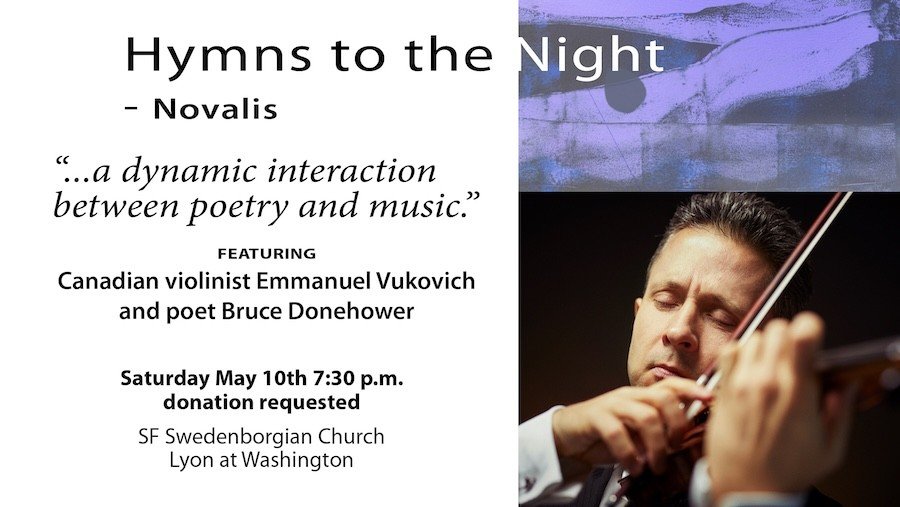Canadian virtuoso, Emmanuel Vukovich
Hymns to the Night
The Fairytale of Eros and Fable
Celebrating the Mountain / 2025 Edition
Hymns to the Night by Novalis is “the most important poem of early [German] romanticism and a work that finds its rank in world literature.
— Herbert Uerlings, from Friedrich von Hardenberg, genannt Novalis (1991).
Our fondest memories are woven through with Novalis.
— Marie Steiner-von Sivers
Dear Friends:
One of the highlights of our 2025 Section Conference was the collaboration between artists who affiliate with different Sections of the School. In this case, I and Emmanuel Vukovich (performing arts) collaborated to present a performance text of Hymns to the Night, one of the most important poems by a poet beloved by Rudolf Steiner and Marie Steiner.
No recording or video was made of this premiere performance. It occurred on May 12 in the Sanctuary of the Swedenborgian Church, a National Historic Monument located on Washington Street in the Pacific Heights of San Francisco, close to the San Francisco Waldorf School.
“. . . reads as if a brilliant English-speaking poet had written them today.”
— Peter Rennick
Hymns to the Night by Novalis
The Fairytale of Eros and Fable by Novalis
Also available at the 2025 Section Conference was The Fairytale of Eros and Fable by Novalis, freshly translated for our 21st century.
The Conference did not make use of this text specifically; it was made available for those friends and members of the Section who share Rudolf Steiner’s enthusiasm for Novalis and who might enjoy this fresh translation or find it helpful.
This fairytale by Novalis complements the canonical Fairy Tale of the Green Snake and Beautiful Lily by Goethe. These two important fairytales should be read as counterpoints to one another. The Fairytale of Eros and Fable is Novalis’s response to Goethe’s Fairy Tale, which Novalis called quite wisely “a narrated opera.”
Goethe’s Fairy Tale came to birth as a result of the friendship between Goethe and Schiller, and friendship is a dominant theme in the Tale. Schiller was the first and primary audience for the work. As is well known, it was the friendship between these two individuals, Goethe and Schiller, that inaugurated the period in European literature known as Weimar Classicism.”
From the Afterword to the Fairy Tale “Goethe in Paradise” by Bruce Donehower
Novalis and Goethe are of course foundational to a literary reading of Rudolf Steiner’s anthroposophy, as indeed Rudolf Steiner indicated many times. Rudolf Steiner called Goethe’s Fairy Tale “the germinal seed” of the anthroposophical movement. When we look at anthroposophy through a literary lens, we find these two significant fairytales framing the larger narrative, one might argue.
Celebrating the Mountain / 2025 Edition
Also available at the 2025 Conference, this book contains poems, essays, and lectures written by Section friends and members.
The edition has been expanded to included the two Day One Keynote Lectures from the eight-day 2024 Section Conference that began in San Francisco and concluded in Toronto. Christiane Haid’s important lecture on Beauty is in this book.
The Fairy Tale of the Green Snake and Beautiful Lily
The “germinal seed” of the anthroposophical movement.
— Rudolf Steiner
Also Available
5.25.25







